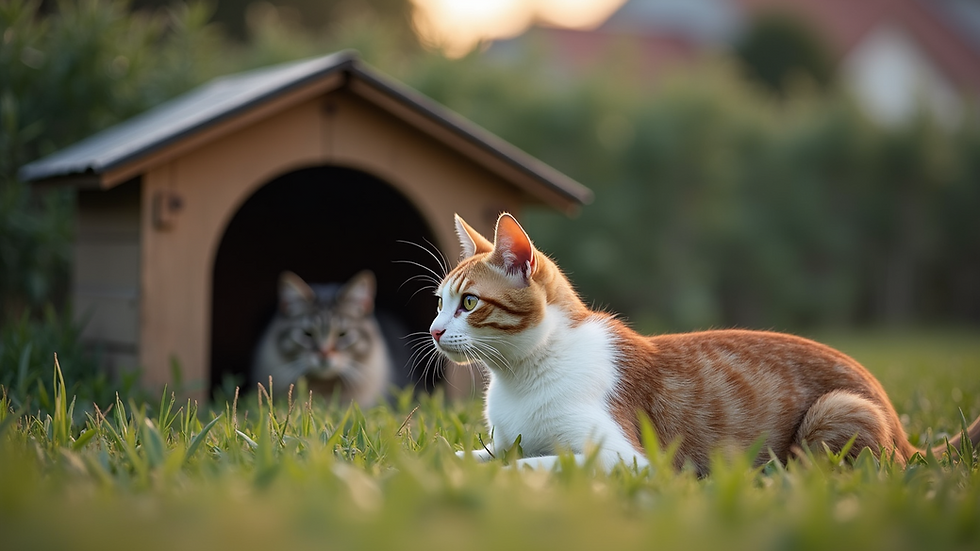The Unseen Impact: How Microchipping Lost Pets Resonates Beyond the Surface
- allpawsreunited
- Mar 25
- 4 min read
Every pet owner knows the absolute terror of potentially losing a beloved furry companion. Whether it’s a mischievous cat sneaking out through an open door or a curious dog that bolts after a squirrel, the anxiety that comes with lost pets can be overwhelming. While there are numerous methods to help find lost pets, one of the most effective solutions is microchipping. But the benefits of microchipping go far beyond simply locating a pet.
This blog post will explore the ripple effect of microchipping lost pets, detailing how this small, inexpensive procedure can significantly impact not only the lives of pets and their families but also the communities and even the broader ecosystem.
The Basics of Microchipping
Microchipping is a simple process that entails implanting a small electronic chip, about the size of a grain of rice, just beneath the skin of the animal. Each chip contains a unique identification number that can be read by a scanner.
When a lost pet is found, a quick scan can reveal the owner’s details, making reunification swift and easy.
This small procedure can typically be done at animal shelters, veterinary clinics, and pet adoption events, and it often takes just a few minutes.
The Chance of Reunification
Statistics show that microchipped pets are significantly more likely to return home than those without identification. According to recent studies, microchipped dogs are reunited with their owners 52% of the time, while for microchipped cats, the rate is even higher at 38%.
These numbers make it clear that microchipping drastically increases the chances of a lost pet being found and returned to its owner.
The emotional relief that comes when a pet is returned can be transformative for families, who often consider their pets as members of the family.
Community Impact
The effects of microchipping extend beyond individual pet owners to include entire communities. In neighborhoods with many microchipped pets, lost and found reports often decrease.
This phenomenon creates a ripple effect, reducing stress for both pet owners and local animal shelters, which may face a surge in homeless pets when families are unable to find their lost loved ones.
Fewer animals in shelters means more resources available for other local animals in need, changing the dynamic of community welfare for pets.
Financial Considerations
The financial implications of microchipping also deserve recognition. When a pet goes lost and cannot be located, the owner may incur numerous costs in their search efforts, including advertisements, posters, and even rewards.
In contrast, microchipping is a one-time, relatively low-cost investment that can save owners from the financial burden associated with prolonged searches.
Additionally, many shelters and rescue organizations include microchipping in their adoption fees, further underlining its importance in pet ownership.
Collaboration with Veterinary Services
Many veterinary services have begun promoting the importance of microchipping.
By conducting outreach and educational programs, they inform the public about the significant benefits of microchipping and make it accessible through affordable options.
This collaboration between veterinarians and pet owners is creating a more informed community, fostering responsible pet ownership, and ensuring that more pets are microchipped.
Environmental Impact
Interestingly, microchipping can also have an indirect environmental impact.
When lost pets are not returned to their families, they may end up wandering, foraging for food, and living in unfamiliar environments.
This behavior can lead to increased wildlife disturbances, particularly in areas where pets and local ecosystems interact.
By increasing the chances of lost pets returning home, microchipping can help alleviate some of this pressure on local wildlife and ecosystems.

Lifesaving Advancements
Beyond merely aiding in reunification, microchipping technology is also evolving.
Recent advancements have introduced microchips that can not only store ID information but also track a pet’s location in real-time.
This technology offers a new dimension of security for pet owners, as it can provide peace of mind in an unpredictable world.
While these innovations are still in early stages, they represent a thrilling step forward in responsible pet ownership.
The Role of Shelters and Rescues
Animal shelters and rescue organizations play a crucial role in promoting microchipping efforts.
Many of these organizations encourage potential adopters to microchip their new pets as part of their adoption process.
By embedding this information into their policies, these organizations ensure that pets are set up for success when they go to their new homes, ultimately leading to fewer strays and abandoned animals.
In this way, the microchipping of lost pets becomes a key tenet in the fight against pet homelessness.
Conclusion
Microchipping lost pets is a simple yet effective method that resonates far beyond its immediate purpose of finding lost animals.
The benefits touch on community welfare, financial savings, environmental conservation, and the innovation of veterinary technology.
As owners, shelters, and communities continue to comprehend the profound ripple effect of microchipping, the hope is that we may see a transformed landscape where fewer pets are lost, and more pets are safely returned to their families.
Emphasizing microchipping as an integral part of responsible pet ownership is not just an investment in a pet's safety; it is a commitment to the welfare of the entire community.

In a world where every moment counts, microchipping can not only safeguard the bond between pets and their owners but can also create a healthier, happier environment for all.
By fostering a culture of microchipping, we not only increase the likelihood of reunification but also strengthen the ties that bind our communities together.






Comments